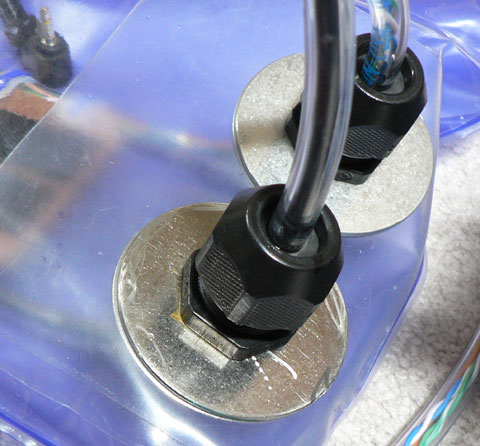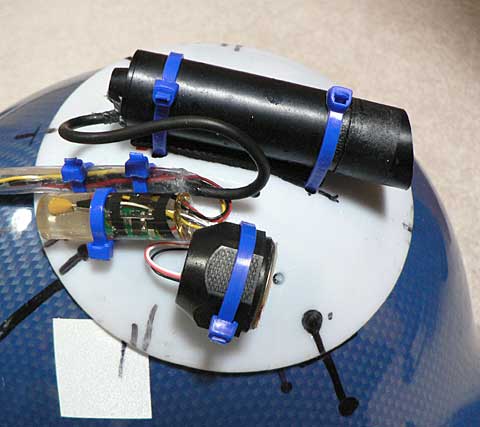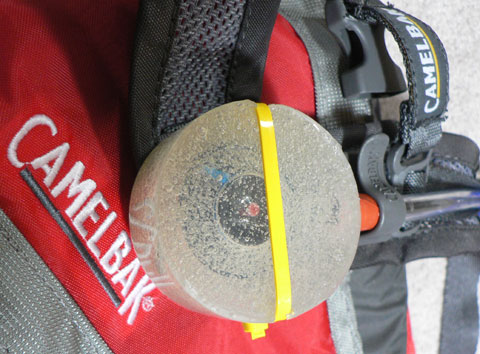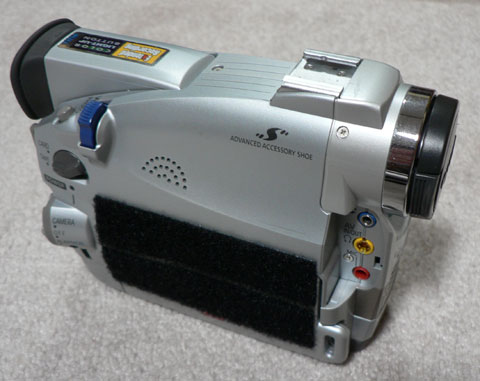The Crooked Cam Mk II is a waterproof helmet cam design, next generation, the initial version used waist-mounted pelican case, which was scary to sail with. Mk II has everything integrated neatly into a small Camelback.
Requirements:
- safe
- waterproof
- film high quality video
- with sound
- convenient
- film other people

Camelback hosts folded Aquapac Jumbo Whanganui with bullet cam batteries and DV camera that acts as a VCR.

Two vinyl tubes lead CAT-5 wires to bulled cam+mic assembly, and to the LANC remote control. MDF board, carrying bullet cam batteries and DV camera, is tied to the tubes. AV and LANC connectors can be seen here. One minor nuisance of the design is the need to open aquapac to disconnect batteries after a session.

IP68 waterproof cable grips are set tight over stainless steel washers from Ace (I had to dremel washers’ internal diameter). The aquapac vinyl is reinforced with dual layer of sail repair tape, from inside and outide.
Bullet cam and mic assembly. Bullet cam is from RFConcepts, it was marketed as 530 lines NTSC color. You can probably get this cam for less stateside as US charges customs from UK. Amazingly sharp full-frame NTSC camera, the only gripe I have is its automatic white balance. It also exhibits some vignetting in the corners, but this is easily dealt with in post-processing.

Mic is submersible to 50 feet (I hope to never test that). Mic amplifier is put close to the mic, so as not to pick up all the radio stations around through the feed cable, is sealed into clear epoxy. (The previous version was sealed in silicone and water has found its way there.) Mic amplifier comes with the camera kit, you can buy one (actually, two) separately, from Hoyt Tech. End of the vinyl tube is silicon-capped.
Everything is tied to a convex piece of plastic. Cam has a little piece of neoprene under it to reduce possible rotation. The plastic platform is fastened to the helmet using 6 small velcro pads. This lets you change helmets (I use gutted skate helmet for sailing with hood in winter), and also easily detaches the cam if something snags the tube behind you, for your neck’s sake.
LANC remote control is fused into platinum cure silicone for watertightness.

Regular silicone caulk does not cut it here as it solidifies from surface, from air moisture. I heard that they now sell a waterproof version of the remote, but did not have a chance to test it.

Canon ZR-30 from Ebay. Shame they don’t make economical LANC-controlled camcorders with AV-in anymore. This lets you record the above full-frame NTSC feed from the bullet cam. Note the velcro strips for the attachment to the board tied to cables.

I use 8mm lens in the bullet cam, which translates to around 50mm lens in 35mm photo analog. You have to actually point it, but it lets you film things other than you hands, boom and sail logo. You have to adjust cam attachment point and the pieces of tape on the glasses to come up with a close reference, but it is well worth it.
The whole construction can be simplified by giving up LANC (easy, as 80 min DV cassette would give you plenty of action) or mic (hard, as I like to mix in the sound) or both.
Make sure to check out videos filmed with this setup.